Surface Characterization of Fracture in Polylactic Acid vs. PLA + Particle (Cu, Al, Graphene) Insertions by 3D Fused Deposition Modeling Technology
Abstract
:1. Introduction
2. Materials and Methods
3. Results and Discussion
- All the samples show almost same absorption peaks as simple PLA, no matter the type of insertion (Cu, Al or graphene),
- PLA + Al and PL + Cu have the same amplitude at 1080 cm−1, meanwhile PLA and PLA + graphene have a lower amplitude at the same frequency (1080 cm−1).
4. Discussion
5. Conclusions
- Regarding the FTIR analysis, all the samples show almost same absorption peaks as simple PLA, no matter the type of insertion (Cu, Al or graphene), PLA + Al and PL + Cu have the same amplitude at 1080 cm−1, meanwhile PLA and PLA + graphene have a lower amplitude at the same frequency (1080 cm−1).
- Regardless the chemical composition of the specimens, the same type of evolution of the values of mechanical strengths can be noticed: they increase slightly with the increase of the filling angle (from 45° to 60°) and decrease with the increase of the filling degree (from 60% to 80% and 100%).
- A hierarchy, in descending order of the elongation values can be observed: simple PLA (4.2%–4.6%) followed by PLA with aluminum particle inserts (3.2–4.1), followed by PLA with particle graphene inserts (2.6%–4%), the lowest values being recorded for PLA specimens with particle copper inserts, 1.8%–2.7%.
- Regarding the fiber heights measured after fracture of the 3D printing materials, the evolution of the fiber heights of all the samples, irrespective of the chemical composition of the samples, is the same: increasing the angle degree or filling percentage lead to a decrease of the fiber height. It means that the ductility potential of the fiber can increase due to these printing parameters; the values of fiber height with different insertions are higher than the simple PLA, in all conditions. A hierarchy may be made: the highest values of the fiber heights are for PLA + particle aluminum, followed by PLA + particle graphene and PLA + particle copper.
- Generally, the samples may be broken in the transition zone with zig-zag fracture, having a brittle/cleavage aspect, irrespective of the chemical composition of the sample.
- The fibers generally break, with small exceptions, in the area of variation of the specimen size, which indicates that the elongation is minimal and the rupture does not occur in the calibrated area of the specimen, meaning that the fracture is predominantly brittle.
- Regarding the SEM analysis, all samples the fracture has the same structural feature, i.e., cleavage aspect, with wave propagation. In addition, one may remark the size of the particles: in PLA + Cu, there are particles around 15–20 µm; in PLA + Al, there are particles around 18–21 µm; in PLA + graphene, there are particles around 2–7 µm.
Author Contributions
Funding
Institutional Review Board Statement
Informed Consent Statement
Data Availability Statement
Conflicts of Interest
References
- Messimer, L.S. Characterization and processing behavior of heated aluminum-polycarbonate composite build plates for the fdm additive manufacturing process. J. Manuf. Mater. Process. 2018, 8, 12. [Google Scholar] [CrossRef] [Green Version]
- Ranjbar, M.; Pardakhty, A.; Tahmipour, B.; Mohamadzadeh, I. Novel CaO/polylactic acid nanoscaffold as dental resin nanocomposites and the investigation of physicochemical properties. Luminescence 2019, 34, 360–367. [Google Scholar] [CrossRef] [PubMed]
- Narayanan, N.; Roychoudhury, P.K.; Srivastava, A. L (+) lactic acid fermentation and its product polymerization. Electron. J. Biotechnol. 2004, 7, 167. [Google Scholar]
- Drumricht, R.E.; Gruber, P.R.; Henton, D.E. Polylactic acid technology. Adv. Mater. 2000, 12, 1841–1846. [Google Scholar] [CrossRef]
- Auras, R.; Harte, B.; Selke, S. An overview of polylactides as packaging materials. Macromol. Biosci. 2004, 4, 835. [Google Scholar] [CrossRef]
- Martin, O.; Avérous, L. Poly (lactic acid): Plasticization and properties of biodegradable multiphase systems. Polymer 2001, 42, 6209–6219. [Google Scholar] [CrossRef]
- Lasprilla, A.J.; Martinez, G.A.; Lunelli, B.H.; Jardini, A.L.; Filho, R.M. Poly-lactic acid synthesis for application in biomedical devices—A review. Biotechnol. Adv. 2012, 30, 321–328. [Google Scholar] [CrossRef] [PubMed]
- Malmgren, T.; Mays, J.; Pyda, M. Characterization of polylactic acid by size exclusion chromatography, differential refractometry, light scattering and thermal analysis. Therm. Anal. Calorim. 2006, 83, 35–40. [Google Scholar] [CrossRef]
- Valerga, A.P.; Batista, M.; Salguero, J.; Girot, F. Influence of PLA filament condition on characteristics of FDM parts. Materials 2018, 11, 1322. [Google Scholar] [CrossRef] [PubMed] [Green Version]
- Creality. Available online: https://www.creality3dshop.eu/collections/cr-series-3d-printer/products/creality-cr-10s-diy-desktop-3d-printer-300x300x400mm (accessed on 20 March 2021).
- All3DP. Available online: https://all3dp.com/2/how-3d-printer-filament-made/ (accessed on 20 March 2021).
- Cavalu, S.; Simon, V. Proteins adsorption to orthopedic biomaterials-vibrational spectroscopic evidence. J. Optoelectron. Adv. Mater. 2007, 9, 3297–3302. [Google Scholar]
- Jamshidian, M.; Tehrany, E.A.; Imran, M.; Jacquot, M.; Desobry, S. Poly-lactic acid: Production, applications, nanocomposites, and release studies. Comprehens. Rev. Food Sci. Food Saf. 2010, 9, 552–571. [Google Scholar] [CrossRef] [PubMed]
- Farah, S.; Anderson, D.G.; Langer, R. Physical and mechanical properties of PLA, and their functions in widespread applications—A comprehensive review. Adv. Drug Deliv. Rev. 2016, 107, 367–392. [Google Scholar] [CrossRef] [Green Version]
- Chacón, J.M.; Caminero, M.A.; García-Plaza, E.; Núñez, P.J. Additive manufacturing of PLA structures using fused deposition modelling: Effect of process parameters on mechanical properties and their optimal selection. Mater. Des. 2017, 124, 143–157. [Google Scholar] [CrossRef]
- Ezeh, O.H.; Susmel, L. Designing additively manufacture notched PLA against static loading. In Proceedings of the International Symposium on Notch Fracture, Santander, Spain, 20 March 2017. [Google Scholar]
- Jadallah, O.; Bagni, C.; Askes, H.; Susmel, L. Microstructural length scale parameters to model the high-cycle fatigue behaviour of notched plain concrete. Int. J. Fatigue 2016, 82, 708–720. [Google Scholar] [CrossRef]
- Jerez-Mesa, R.; Travieso-Rodriguez, J.A.; Llumà-Fuentes, J.; Gomez-Gras, G.; Puig, D. Fatigue lifespan study of PLA parts obtained by additive manufacturing. Procedia Manuf. 2017, 13, 872–879. [Google Scholar] [CrossRef] [Green Version]
- Lanzotti, A.; Grasso, M.; Staiano, G.; Martorelli, M. The impact of process parameters on mechanical properties of parts fabricated in PLA with an open-source 3-D printer. Rapid Prototyp. J. 2015, 21, 604–617. [Google Scholar] [CrossRef] [Green Version]
- Ezeh, O.H.; Susmel, L. On the fatigue strength of 3D-printed polylactide (PLA). Procedia Struct. Integr. 2018, 9, 29–36. [Google Scholar] [CrossRef]
- DeStefano, V.; Khan, S.; Tabada, A. Applications of PLA in modern medicine. Eng. Regen. 2020, 1, 76–87. [Google Scholar]
- Ranjbar, M.; DehghanNoudeh, G.; Hashemipour, M.A.; Mohamadzadeh, I. A systematic study and effect of PLA/Al2O3 nanoscaffolds as dental resins: Mechanochemical properties. Artif. Cells Nanomed. Biotechnol. 2019, 47, 201–209. [Google Scholar] [CrossRef] [PubMed] [Green Version]
- Haifeng, X.; Xiaozu, W.; Yu, W.; Feimin, Z.; Chen, C.; Yang, X. Effects of sol-gel processed silica coating on bond strength of resin cements to glass-infiltrated alumina ceramic. J. Adhes. Dent. 2009, 11, 49–55. [Google Scholar]
- Weiguo, W.; Xiang, S.; Li, H.; Yu, G.; Jinghao, B.; Lijuan, S.; Jihua, C. Structure-property relationships in hybrid dental nanocomposite resins containing monofunctional and multifunctional polyhedral oligomericsilsesquioxanes. Int. J. Nanomed. 2014, 10, 841–852. [Google Scholar]
- Mirjalil, F.; Chuah, L.; Salahi, E. Mechanical and morphological properties of polypropylene/nano α-Al2O3 composites. Sci. World J. 2014, 2014, 718765. [Google Scholar]
- Cavalu, S.; Banica, F.; Simon, V. Surface modification of alumina/zirconia ceramics upon different fluoride-based treatments. Int. J. Appl. Ceram. Technol. 2014, 11, 402–411. [Google Scholar] [CrossRef]
- Speroff, L.; Darney, P.D. Intrauterine contraception. In A Clinical Guide for Contraception, 5th ed.; Lippincott Williams Wilkins: Philadelphia, PA, USA, 2011; pp. 239–280. ISBN 978-1-60831-610-6. [Google Scholar]
- World Health Organization. World Health Organization Model List of Essential Medicines: 21st LIST 2019; World Health Organization: Geneva, Switzerland, 2019. [Google Scholar]
- Berger-Kulemann, V.; Einspieler, H.; Hachemian, N.; Prayer, D.; Trattnig, S.; Weber, M.; Ba-Ssalamah, A. Magnetic field interactions of copper-containing intrauterine devices in 3.0-tesla magnetic resonance imaging: In vivo study. Korean J. Radiol. 2013, 14, 416–422. [Google Scholar] [CrossRef] [PubMed]
- Hashim, N.; Yusoh, K. Graphene modifications in polylactic acid nanocomposites: A review. Polym. Bull. 2015, 72, 931–961. [Google Scholar]
- Reza, A.; Azman, H.; Norhayani, O.; Zurina, M. Characterizations of Carbon-Based Polypropylene. In Carbon-Based Polymer Nanocomposites for Environmental and Energy Applications; Elsevier Science: Johor Bahru, Malaysia, 2018. [Google Scholar] [CrossRef]
- Sumit, G.; Vinayak, S.; Shilpa, S. Graphene-based nanomaterials for drug delivery and tissue engineering. J. Control. Release 2013, 173, 75–88. [Google Scholar]
- Hu, S.; Zeng, Y.; Yang, S.; Qin, H.; Cai, H.; Wang, J. Application of Graphene Based Nanotechnology in Stem Cells Research. J. Nanosci. and Nanotech. 2015, 15, 6327–6341. [Google Scholar] [CrossRef]
- Edelmann, J.; Albrecht, M.; Gehde, M.; Adamy, M.; Hopmann, C.; Deferme, W.; Lecomte, J. Graphen—Möglichkeiten und Grenzen in polymeren Kompositen. In Proceedings of the Technomer 2017: Fachtagungüber Verarbeitung und Anwendung von Polymeren, Chemnitz, Germany, 25–27 October 2017; p. 25. [Google Scholar]
- Dobrescu, T.; Pascu, N.E.; Jiga, G.; Simion, I.; Adir, V.; Enciu, G.; Tudose, D.D. Tensile behavior of PLA and PLA composite materials under different printing parameters. Mater. Plast. 2019, 56, 783–800. [Google Scholar] [CrossRef]
- Instron 8800. Available online: https://www.instron.us/en-us/products/testing-systems/dynamic-and-fatigue-systems/8800-high-strain-rate (accessed on 20 March 2021).
- Olympus. Available online: https://www.olympus-lifescience.com/en/microscopes/stereo/szx7/ (accessed on 20 March 2021).
- Nagendra, K.M.; Vikas, R.; Pushpendra, S. An overview of mechanical properties and form error for rapid prototyping. CIRP J. Manuf. Sci. Technol. 2020, 29, 53–70. [Google Scholar]
- Wittbrodt, B.; Pearce, J.M. The effects of PLA color on material properties of 3-D printedcomponents. Addit. Manuf. 2015, 8, 110–111. [Google Scholar]
- Ning, F.; Cong, W.; Qiu, J.; Wei, J.; Wang, S. Additive manufacturing of carbon fiber reinforced thermoplastic composites using fused deposition modeling. Compos. Part B Eng. 2015, 80, 369–378. [Google Scholar] [CrossRef]
- Goh, G.D.; Toh, W.; Yap, Y.L.; Ng, T.Y.; Yeong, W.Y. Additively manufactured continuous carbon fiber reinforced thermoplastic for topology optimized unmanned aerial vehicle structures. Compos. Part B Eng. 2021, 216, 108840. [Google Scholar] [CrossRef]
- Naranjo-Lozada, J.; Ahuett-Garza, H.; Orta-Castañón, P.; Verbeeten, W.M.; Sáiz-González, D. Tensile properties and failure behavior of chopped and continuous carbon fiber composites produced by additive manufacturing. Addit. Manuf. 2019, 26, 227–241. [Google Scholar] [CrossRef]
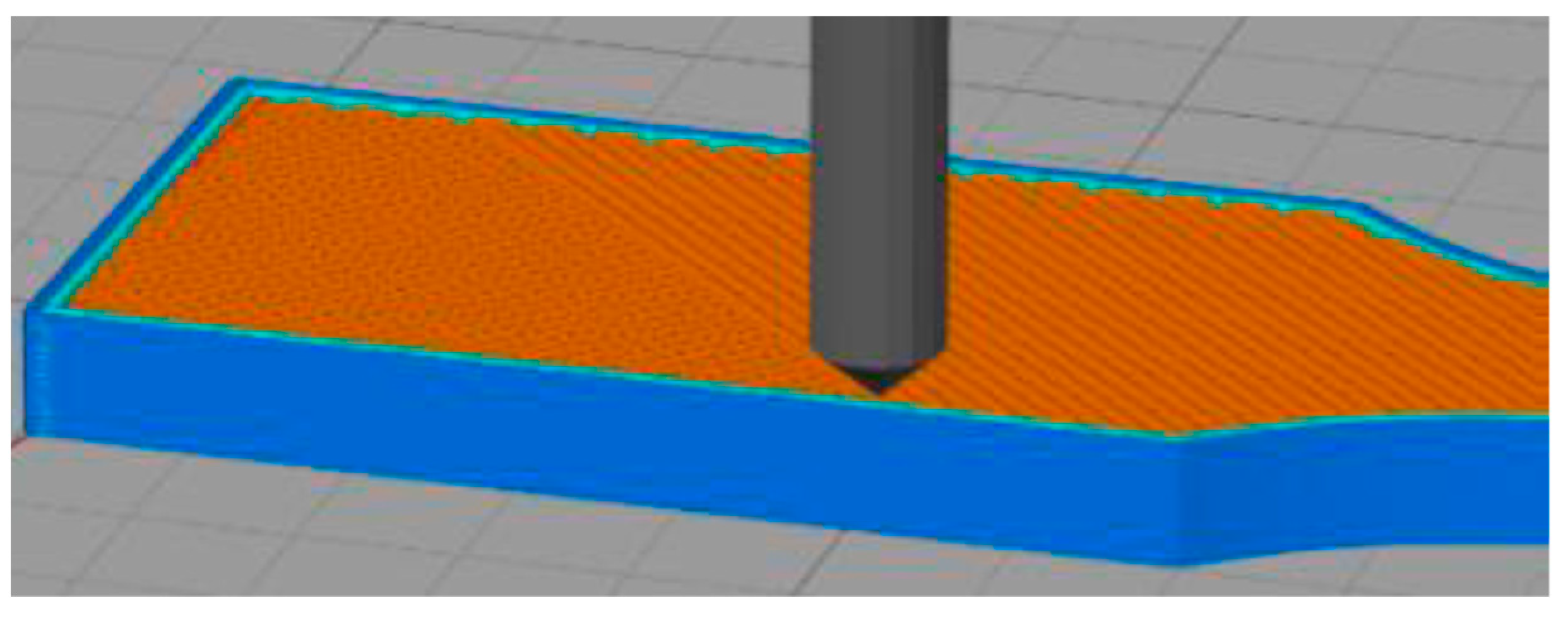

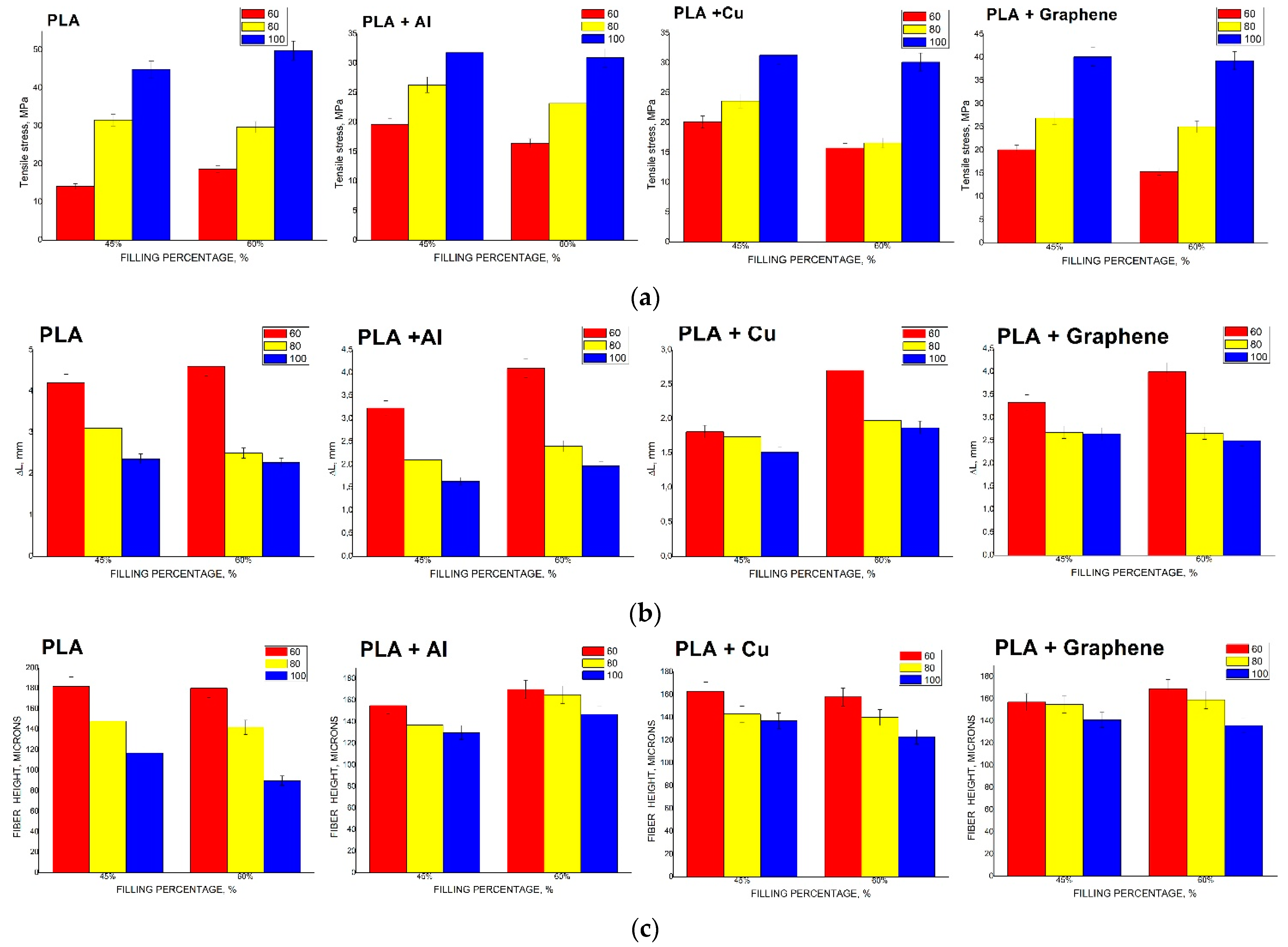



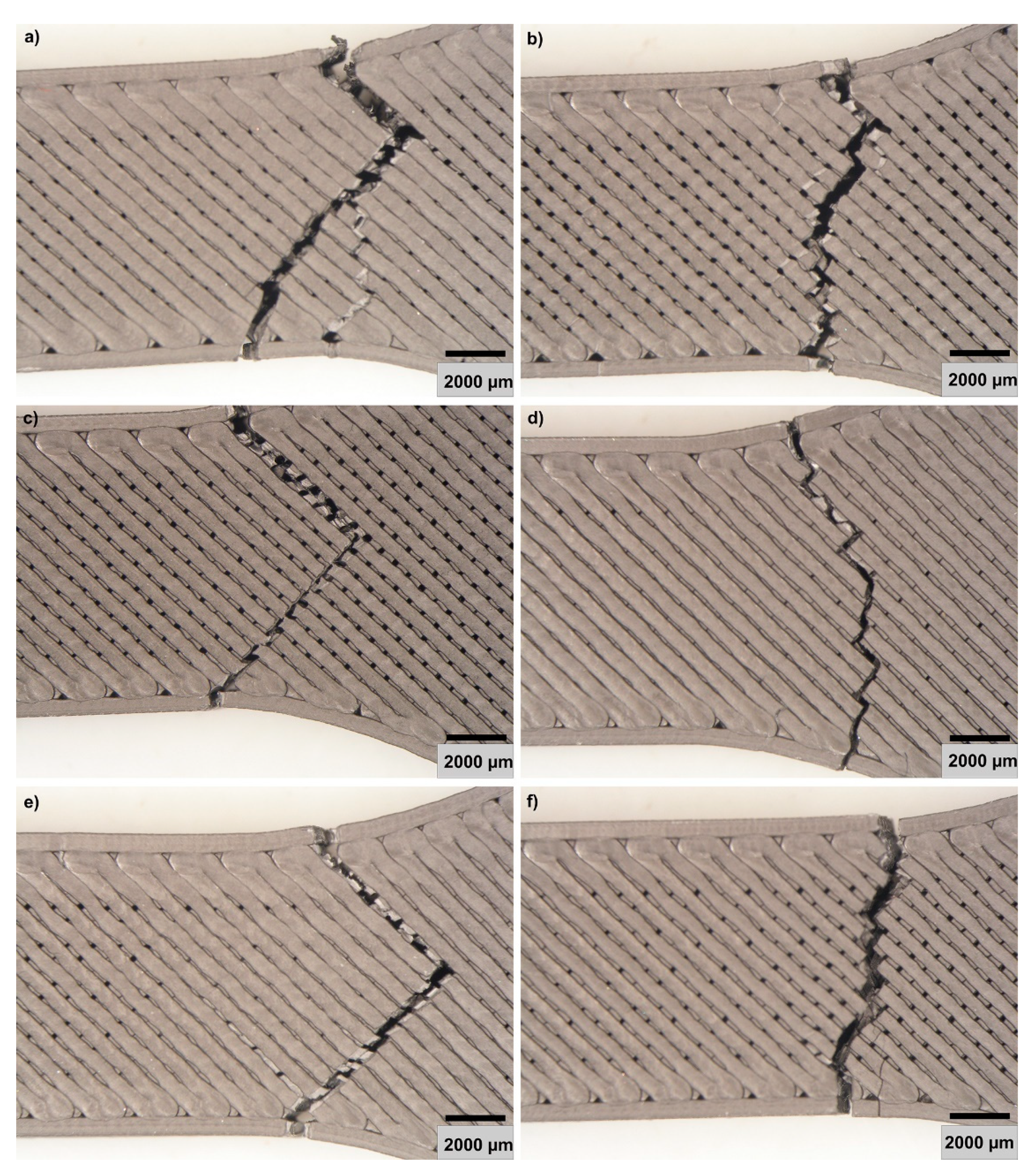
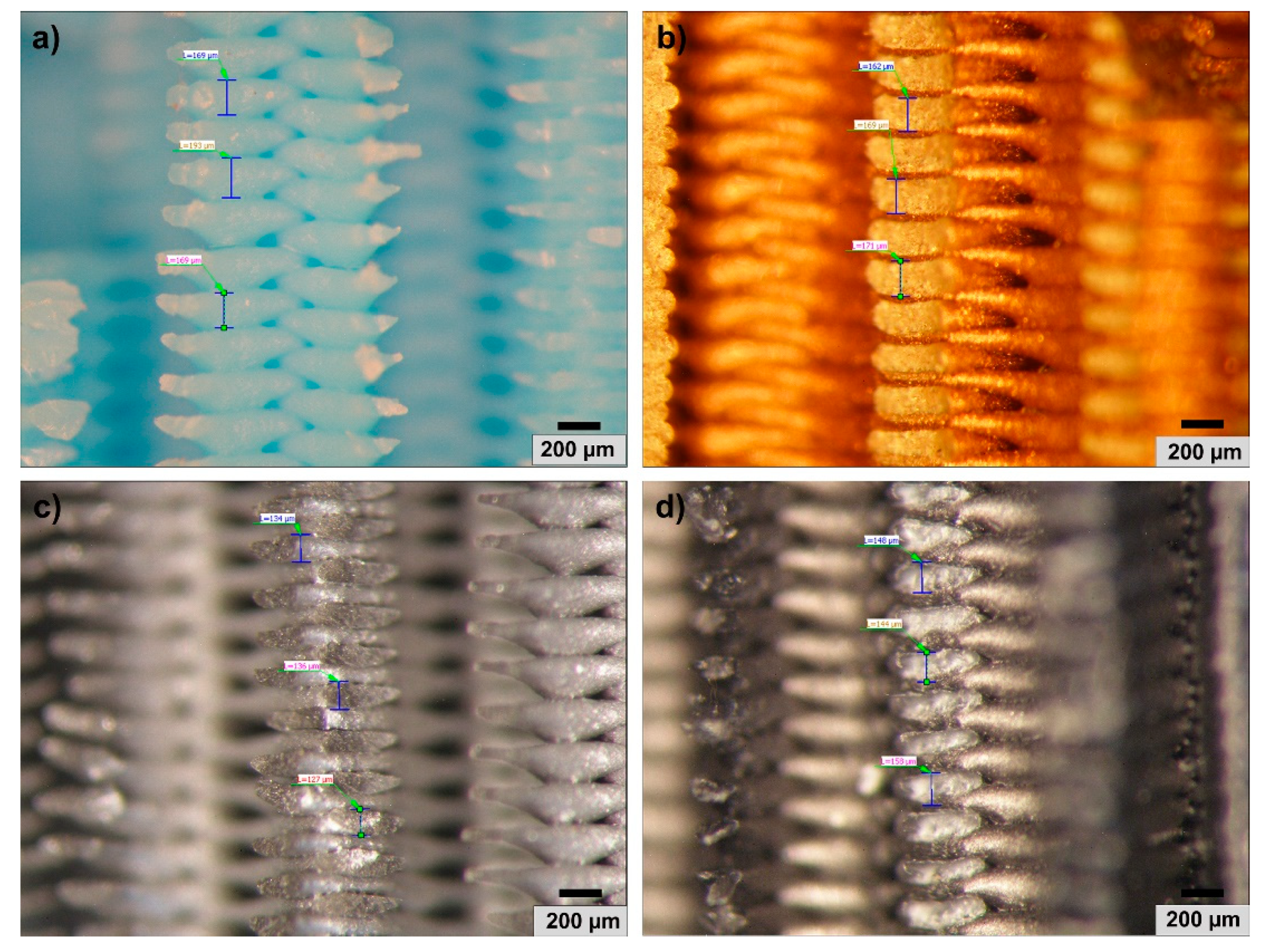

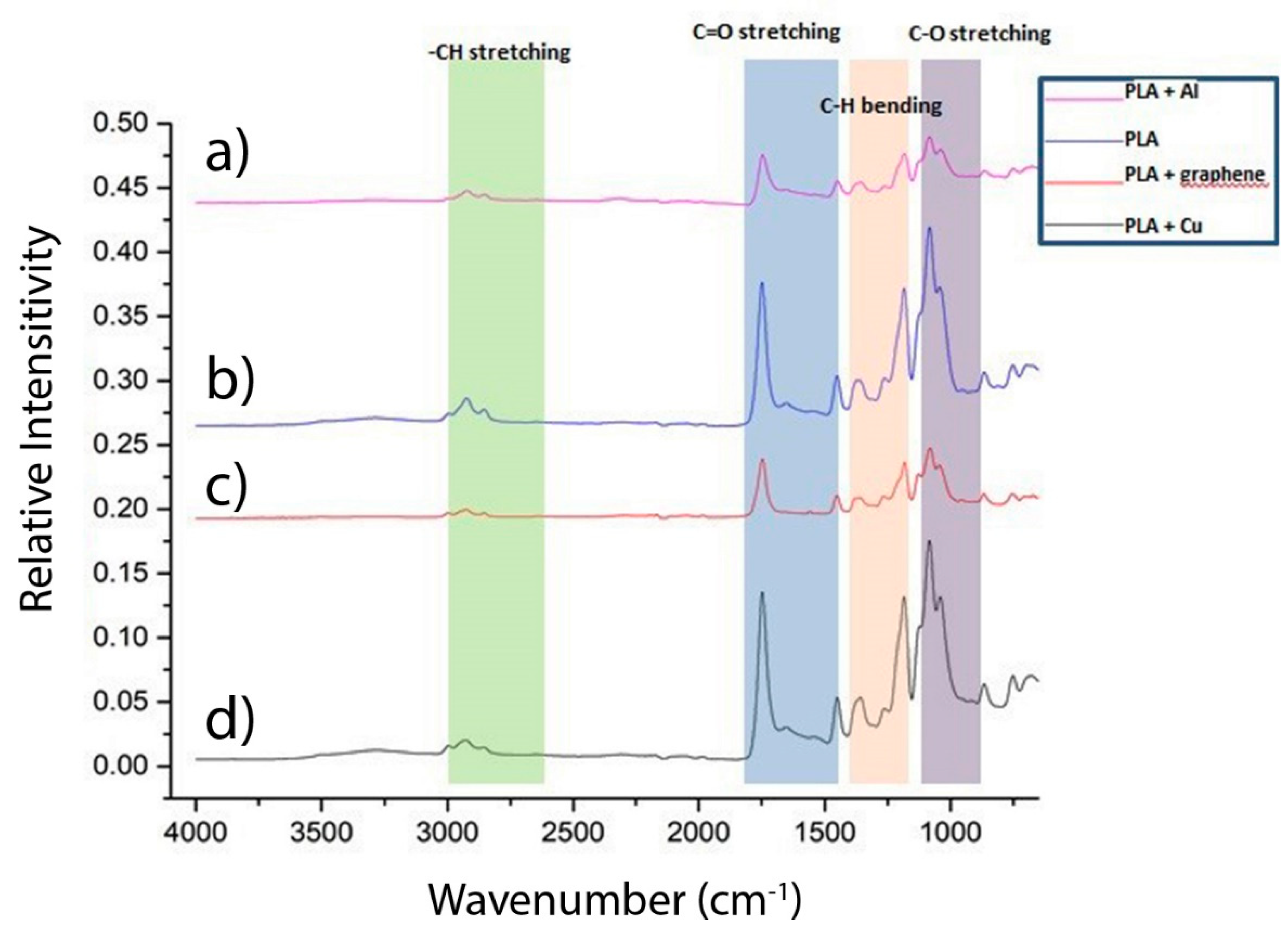
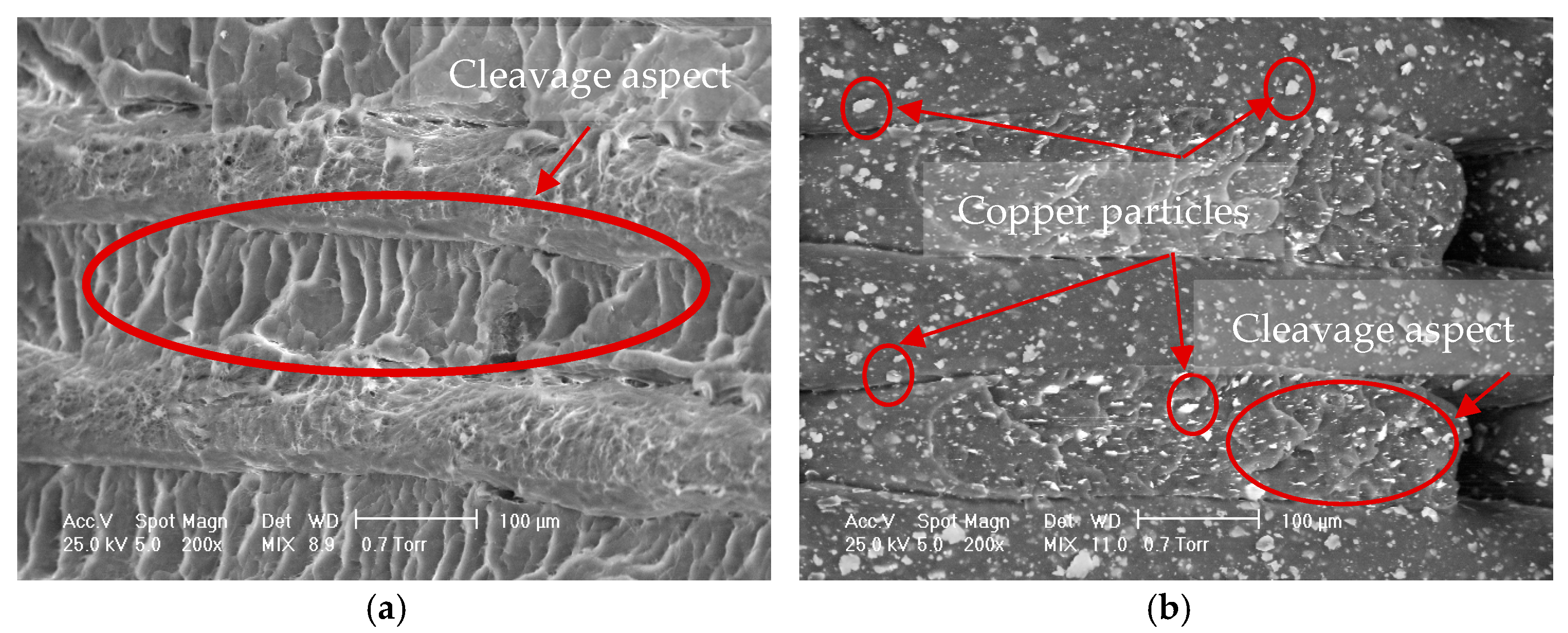
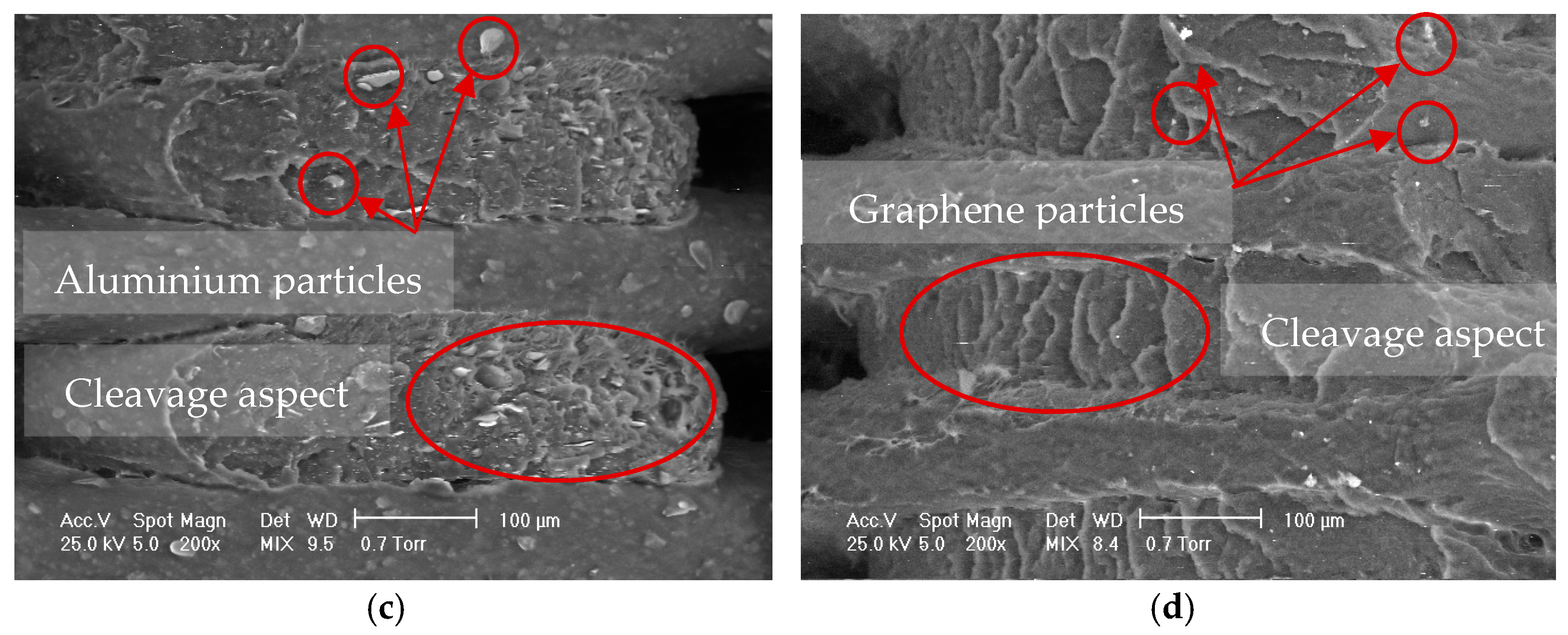
Publisher’s Note: MDPI stays neutral with regard to jurisdictional claims in published maps and institutional affiliations. |
© 2021 by the authors. Licensee MDPI, Basel, Switzerland. This article is an open access article distributed under the terms and conditions of the Creative Commons Attribution (CC BY) license (https://creativecommons.org/licenses/by/4.0/).
Share and Cite
Ghiban, B.; Pascu, N.E.; Antoniac, I.V.; Jiga, G.; Milea, C.; Petre, G.; Gheorghe, C.; Munteanu, C.; Istrate, B. Surface Characterization of Fracture in Polylactic Acid vs. PLA + Particle (Cu, Al, Graphene) Insertions by 3D Fused Deposition Modeling Technology. Coatings 2021, 11, 633. https://doi.org/10.3390/coatings11060633
Ghiban B, Pascu NE, Antoniac IV, Jiga G, Milea C, Petre G, Gheorghe C, Munteanu C, Istrate B. Surface Characterization of Fracture in Polylactic Acid vs. PLA + Particle (Cu, Al, Graphene) Insertions by 3D Fused Deposition Modeling Technology. Coatings. 2021; 11(6):633. https://doi.org/10.3390/coatings11060633
Chicago/Turabian StyleGhiban, Brândușa, Nicoleta Elisabeta Pascu, Iulian Vasile Antoniac, Gabriel Jiga, Claudia Milea, Gabriela Petre, Cristina Gheorghe, Corneliu Munteanu, and Bogdan Istrate. 2021. "Surface Characterization of Fracture in Polylactic Acid vs. PLA + Particle (Cu, Al, Graphene) Insertions by 3D Fused Deposition Modeling Technology" Coatings 11, no. 6: 633. https://doi.org/10.3390/coatings11060633







